Bonsai is art of cultivating miniature trees in pots, reproducing beauty and form of mature trees. This ancient Japanese practice combines aesthetics and patience, requiring pruning, wiring and meticulous care techniques to shape a bonsai. Contrary to common belief, bonsai are not trees born small. They are ordinary trees maintained with specific techniques to limit their growth. Their height sometimes does not exceed 15 centimetres for mame bonsai or mini-bonsai! Here are essential tips to master pruning of your bonsai and achieve a harmonious, well-structured tree.
Can any tree be made into a bonsai?
Not all tree or bush species lend themselves to miniaturisation. Beauty of a bonsai depends on ability to reproduce, on small scale, proportions and silhouette of a mature tree in nature. Some species grow too quickly or have specific environmental requirements that make them difficult to maintain as bonsai. Trees with an imposing root system or that do not tolerate regular pruning well are not suited to miniaturisation. Species with small leaves or needles are better suited to creating harmonious miniatures than those with overly large leaves or rigid branches. Many conifers are suitable for forming a bonsai. Species that have good capacity to ramify, that is to produce numerous secondary branches, are also good candidates. This capacity is essential to create density and complexity of the branches characteristic of bonsai. Deciduous trees, conifers, flowering trees and bushes — fortunately many species are particularly well suited to bonsai formation. They are chosen for foliage that changes colour with seasons or for attractive flowers. They have characteristics that ease shaping, such as good tolerance of repeated pruning and strong wound-healing ability.
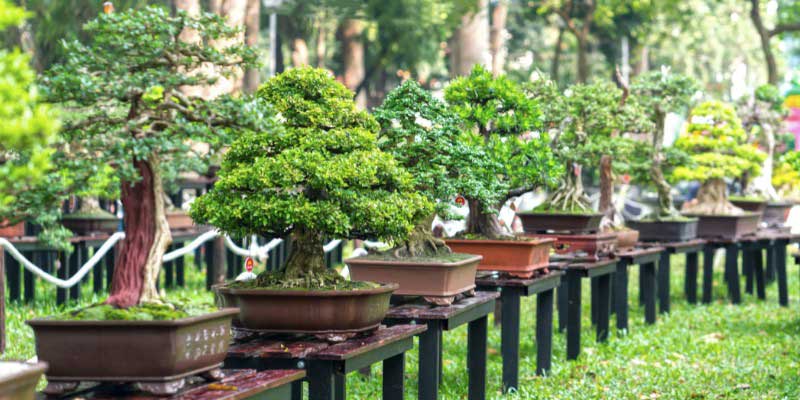
Which type of bonsai to choose?
Among species sought for ease of miniaturisation, look to:
Conifers:
- Scots pine, Black pine, Mugo pine, Japanese white pine: these pines are valued for resilience and aesthetics.
- Yew, Spruce, Larch (deciduous conifer): these conifers tolerate pruning and wiring well.
Evergreen broadleaves:
- Boxwood: very hardy and easy to shape.
- Juniper: particularly well suited to deadwood techniques (jin and shari) that create dramatic, natural effects by imitating old, weather-exposed trees.
- Holly: with many species, offers a wide variety of shapes and foliage.
- Cotoneaster, Pyracantha: valued for small fruits and dense foliage.
- Fukien tea (Carmona retusa): native to southern China, prized for dense evergreen foliage and small white flowers, it is one of most used species for indoor bonsai. It stands out for ease of care.
Deciduous broadleaves:
- Apple and ornamental cherry, Japanese quince: these fruiting trees are interesting for decorative flowers and fruits.
- Japanese maple, Field maple: known for palmate foliage and magnificent autumn colours.
- Beech, Elm: classic bonsai with attractive bark and fine branching.
- Ginkgo biloba: famous for fan-shaped leaves.
- European nettle tree, Wisteria: valued for flowers and rapid growth.
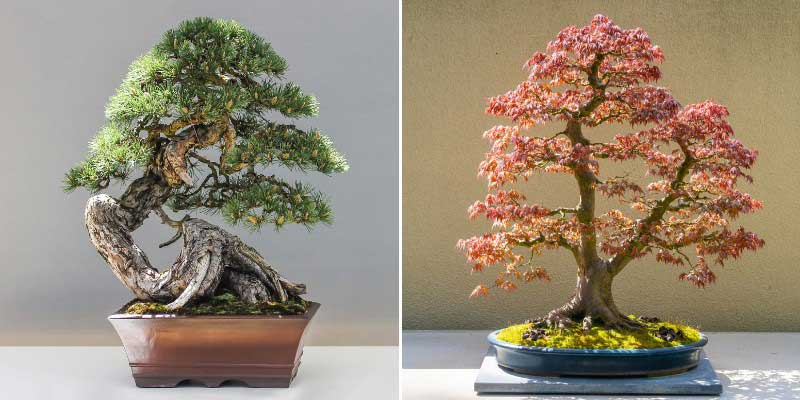
For an indoor bonsai:
- Ficus: one of most used species for indoor bonsai
- Crassula (jade plant): a succulent plant that tolerates dry indoor environments and needs little water. Prefers bright, even direct light.
- Serissa (snow rose): also known as "Snow Rose", it produces small white flowers throughout year. Requires bright light and consistent humidity.
- Sageretia (Chinese plum): prized for glossy foliage and small colourful berries. Requires bright light and regular watering to maintain humidity.
- Gardenia and Camellia: they offer very decorative flowering.
Start from a young plant to succeed with your bonsai
Starting with a young plant or pre-bonsai is often the best option to form a bonsai. Young plants are easier to shape because their branches and trunk are still flexible. You can model them more easily and structure them throughout growth stages. You will shape your small subject progressively without fear of damaging a mature tree. This helps develop skills and confidence. Choose a species suited to bonsai, such as juniper, ficus or Japanese maple, and suited to your climate if you want an outdoor bonsai. To do this, several options:
- Collect a young specimen from wild or choose one at your favourite nursery. Look for a healthy young plant with a well-formed trunk and no signs of disease or pests.
- Grow a bonsai from seed, a slow but very rewarding method. This allows control of tree formation from first years. Expect at least 3 to 5 years before tree can be shaped.
- Create bonsai from cuttings or by layering. This low-cost method, faster than sowing, yields trees with characteristics of parent plant. You can shape tree according to desired form.
- For young plants from sowing, propagation by cuttings or layering, wait one to two years before performing first pruning.
- For those preferring a partly formed tree, pre-formed bonsai are another option. These trees already have a basic structure and mainly require maintenance care and minor adjustments.
- In all cases, choose suitable pot that can contain roots of your tree, no more, and plant young plant in it before any pruning operation.
When to shape a bonsai?
Maintenance pruning can be done throughout growth period, generally spring to autumn, after flowering for flowering trees. Leaves should be pruned regularly during this period. Structural pruning is carried out in early spring or late autumn, outside periods of active growth and winter dormancy. Avoid working on bonsai during winter rest periods, as tree is more vulnerable and will struggle to heal.
How to give a bonsai its shape?
Necessary equipment:
- A concave cutter
- A pair of standard scissors
- Long fine scissors
- A pruning shear
- A small saw
- Jin pliers (if needed)
- Calcium sulphate (if required for deadwood)
- Wire pliers
- Wiring (aluminium or anodised copper)
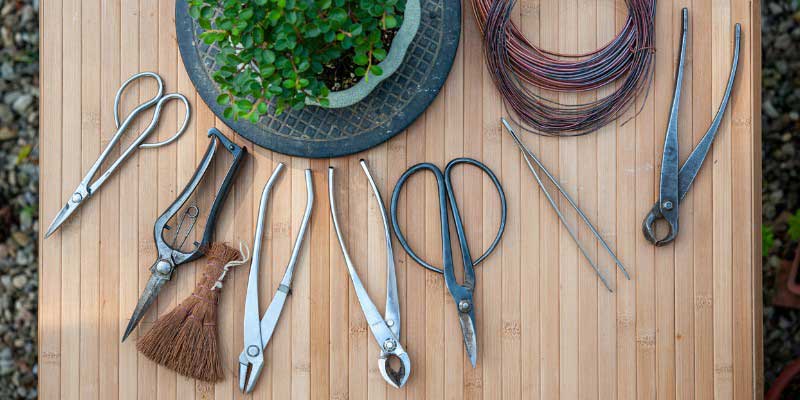
To preserve initial shape of a bonsai, pruning is essential. While maintenance pruning is necessary to keep tree form, structural pruning is essential to give tree its base shape. This is not topiary work. Although miniature, appearance should remain natural. To maintain and shape a bonsai it is essential to master these two types of pruning. To form a bonsai step by step:
Structural pruning of bonsai:
Structural or formation pruning is essential to establish base structure and shape of bonsai. It will directly affect tree’s visual aspect. It is generally carried out in spring on young plants and involves larger cuts to direct tree growth. Its objectives: create main structure of tree, define silhouette (cloud style, conical..) and guiding lines, and encourage branching and development of secondary branches.
- Use sharp, disinfected pruning tools to avoid damaging tree.
- Place tree on eye-height table to observe it better and decide on future shape and branches to remove.
- Choose main branches: Select main branches that will form base structure. Using special bonsai scissors, remove misplaced or twisted branches that unbalance tree shape, and dead or damaged branches. Keep only one of two branches at same height and remove the other. Remove vertically growing branches and those too thick at top of tree, since lower branches should be thicker than those at the apex.
- Create levels: Prune to create tiers or "levels" of branches. Each level should be arranged evenly around trunk.
- Make clean, angled cuts to encourage rapid healing. Cut branches on bias just above a node or a leaf to promote new growth.
- Apply a wound-sealing putty to large wounds.
- Use wiring: Complement pruning with wiring. Wrap wiring in aluminium or copper around a branch at a 45-degree angle, taking care not to over-tighten, to position and guide branches. Gently bend branches to desired shape. Leave wire in place for several months and remove before it leaves permanent marks.
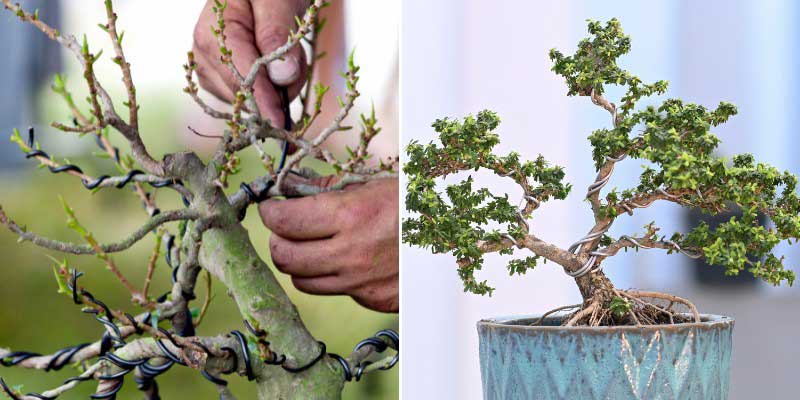
Maintenance pruning of bonsai:
Maintenance pruning is carried out regularly to keep bonsai shape and size. It consists of less drastic but more frequent cuts to control growth. Its aim is to maintain compact, aesthetic silhouette, encourage dense, balanced branching and remove unwanted shoots.
- Pinch new shoots: Pinching is pruning of bonsai buds. It involves removing tip of new shoots with fingers (for conifers to avoid brown tips and damage to needles) by gently pulling between thumb and forefinger, or using fine scissors (for deciduous or evergreen trees) to maintain compact silhouette. Cut just above a bud. This encourages growth of several new branches from cut point.
- Shorten lignified shoots leaving two or three leaves.
- Remove unwanted shoots: Eliminate dead shoots, those protruding from crown or growing in undesired directions, notably inward toward centre of tree.
- Defoliate on deciduous subjects: In June, at start of summer, when tree is in full vigour, dare to cut leaves using fine scissors while leaving petioles intact. You can defoliate only the apex or whole tree. By removing existing leaves, tree will produce smaller new leaves, desirable to maintain miniature proportions of bonsai. Defoliation stimulates growth of new shoots and branches, increasing density of branching and creating more complex, balanced structure.
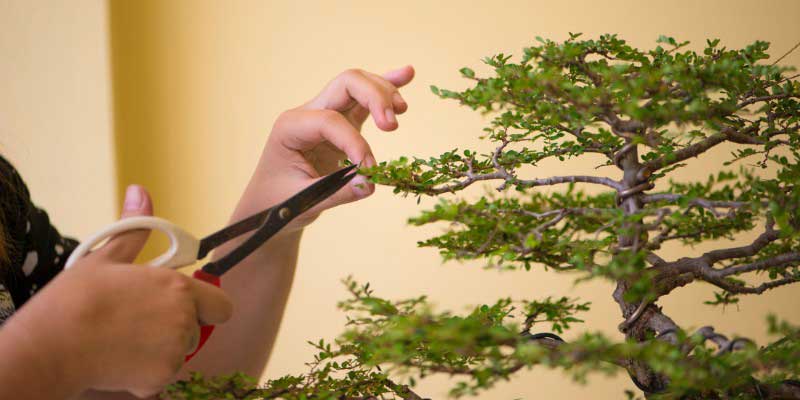
Working deadwood in bonsai
Deadwood, known by Japanese terms "jin" and "shari", is a technique used in bonsai art to create parts of tree that appear dead. This gives impression of an ancient tree exposed to elements, adding character and aesthetics to composition. Jin involves creating dead sections on branches, while shari creates areas of trunk stripped of bark. This technique applies to evergreen trees. Making a jin or shari requires experience! It is carried out in early spring or late summer. Bonsaï Empire site reveals step-by-step guide to learn creation of jin and shari.































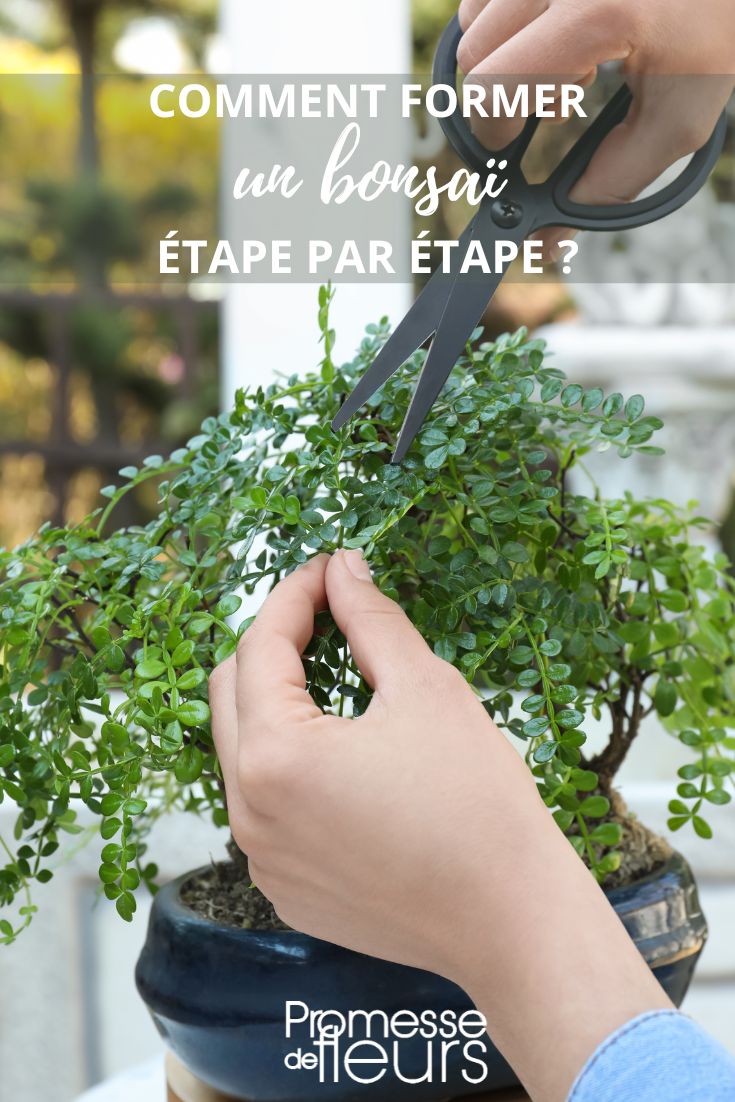
Comments